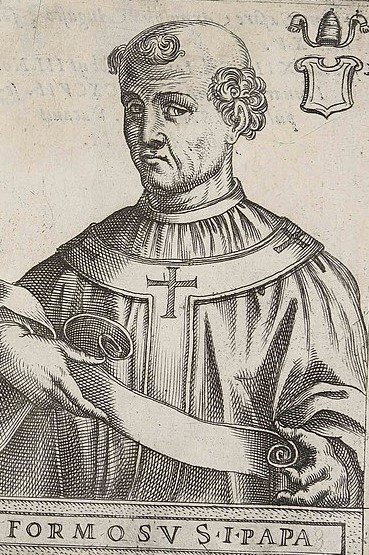Trial of a corpse
The Synod of Formosus

Copperplate engraving of Pope Formosus in Giovanni Battista Cavalieri, Pontificum Romanorum effigies, Rome, National Library of Trento, 1580 - wikimedia commons
Between the last decades of the 9th century and 10th century, Rome experienced a turbulent period where the papal seat was controlled by various city factions. The most important of these were the pro-French faction, led by Guido II, Duke of Spoleto, and his wife Ageltrude, and the pro-German faction, led by Pope Formosus. The situation escalated in 891 when Guido II had himself crowned emperor by the previous Pope Stephen V. However, the pro-German faction was not content with this. The new Pope Formosus initially ratified Guido’s appointment but later, in 894, sought the help of the German Arnulf of Carinthia. The Pope’s wavering politics led to a revolt by all the Roman factions, including the pro-German one, just as Guido II died, leaving power to his son Lambert and his wife.
This situation prompted Arnulf to march into Italy, where he was crowned by Formosus in Rome, forcing Lambert and his allies to retreat to Spoleto. Arnulf decided to settle the matter with his opponents, but a sudden illness forced him to return to Germany, giving Ageltrude free rein. The troops of Spoleto besieged Rome, captured it, and forced Formosus to take refuge in Castel Sant’Angelo, where he soon mysteriously died, possibly poisoned. Ageltrude then arranged for Stephen VI to be elected as the new pope and, together with him, prepared a posthumous trial for Formosus.
This trial, known in history as the "Cadaver Synod," took place in February-March 897. The defendant, Formosus, who had been dead for months and was already decomposed, was exhumed, dressed in full papal vestments, brought into the tribunal, and seated on a throne in the Council hall. The prosecution was led by Stephen VI, while the defense was entrusted to a deacon, who was understandably terrified and had to stand beside the corpse throughout the trial. Unsurprisingly, Formosus was found guilty. He was stripped of his sacred vestments, mutilated by having the first three fingers of his right hand, his arms, and legs cut off, thrown to the enraged crowd, and what remained of him was finally cast into the Tiber. He was later rehabilitated by subsequent popes, but understandably, none of them ever took his name again.
- L., Sperduti, Storia segreta del Papato, Newton Compton Editors, Rome, 2017;
- G., Staffa, L'incredibile storia del Medieovo. Un viaggio affascinante nell'Italia divisa tra Impero e Papato, Newton Compton Editors, Rome, 2017;
Scarpato Deborah - Master's student - Ca' Foscari University - Venice
None
Salvatore Ciccarello
